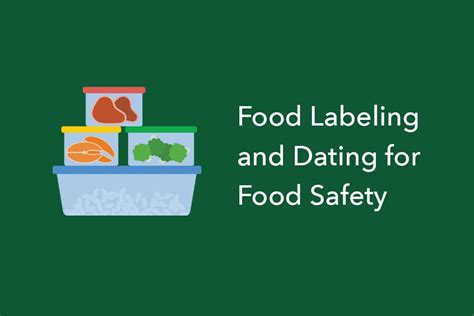Introduction
In today’s fast-paced world, consumers are increasingly concerned about the safety and quality of the food they eat. Food safety and labeling play a crucial role in ensuring that food products are safe for consumption.

Food Safety
According to the World Health Organization (WHO), an estimated 600 million people fall ill from foodborne diseases each year. Foodborne diseases can range from mild discomfort to severe illness or even death.
Key Principles of Food Safety
- Clean: Keep surfaces, hands, and equipment clean to prevent contamination.
- Separate: Avoid cross-contamination by separating raw meat, poultry, seafood, and eggs from other foods.
- Cook: Cook foods to the appropriate internal temperatures to kill harmful bacteria.
- Chill: Refrigerate perishable foods promptly to prevent bacterial growth.
Food Labeling
Food labeling provides consumers with essential information about the products they are purchasing. This information includes:
- Ingredient List: Lists the ingredients used in the product in descending order by weight.
- Nutrition Facts Panel: Provides detailed information on the nutritional content of the product, including calories, fat, carbohydrates, protein, vitamins, and minerals.
- Allergen Information: Highlights any potential allergens present in the product, such as nuts, milk, eggs, or wheat.
- Expiration Date: Indicates the date beyond which the product is not recommended for consumption.
Importance of Food Labeling
- Informed Choices: Allows consumers to make well-informed decisions about the food they eat, considering their dietary needs and preferences.
- Allergy Prevention: Identifies potential allergens, enabling consumers to avoid foods that could trigger allergic reactions.
- Nutritional Value: Provides information on the nutritional content of foods, allowing consumers to monitor their intake and make healthy choices.
Current Challenges and Innovations in Food Safety and Labeling
Challenges
- Foodborne Outbreaks: Foodborne disease outbreaks remain a significant concern, highlighting the need for improved food safety practices throughout the supply chain.
- Mislabeling: Intentional or unintentional mislabeling can mislead consumers and pose health risks, especially for people with food allergies or intolerances.
- Sustainability: Concerns over food safety and labeling extend beyond consumer health to include environmental sustainability and ethical considerations.
Innovations
- Blockchain Technology: Blockchain can enhance traceability and transparency throughout the food supply chain, improving food safety and reducing the risk of fraud.
- Biosensors: Biosensors can rapidly detect pathogens and contaminants in food, enabling timely intervention and reducing the risk of foodborne illness.
- Smart Packaging: Smart packaging technologies can monitor food quality and detect spoilage, providing consumers with real-time information about the freshness of their products.
Common Mistakes to Avoid
- Not Reading Food Labels Carefully: Ignoring the information on food labels can lead to potential health risks or nutritional deficiencies.
- Ignoring Expiration Dates: Consuming expired foods can result in foodborne illness or spoilage.
- Ignoring Allergen Information: Failing to check for potential allergens can put consumers at risk of allergic reactions.
FAQs
Q1: What are the most common foodborne illnesses?
A1: The most common foodborne illnesses include salmonella, E. coli, listeria, and norovirus.
Q2: How can I prevent foodborne illness?
A2: Follow safe food handling practices, such as cleaning surfaces, separating foods, cooking to appropriate temperatures, and chilling perishable foods.
Q3: What should I do if I suspect food poisoning?
A3: Seek medical attention immediately. Symptoms of food poisoning can include nausea, vomiting, diarrhea, and abdominal pain.
Q4: What is the role of government agencies in food safety?
A4: Government agencies, such as the FDA and USDA, regulate food safety standards, conduct inspections, and recall contaminated products.
Reviews
Review 1: “This article provides a comprehensive overview of food safety and labeling. It’s well-written and informative, making it a valuable resource for consumers.”
Review 2: “As a healthcare professional, I appreciate the emphasis on food safety and the importance of following safe food handling practices.”
Review 3: “I’m impressed with the discussion of current challenges and innovations in the field. It highlights the ongoing efforts to improve food safety and labeling practices.”
Review 4: “This article is an excellent resource for consumers who want to make informed choices about the food they eat. The FAQs section is particularly helpful.”





















